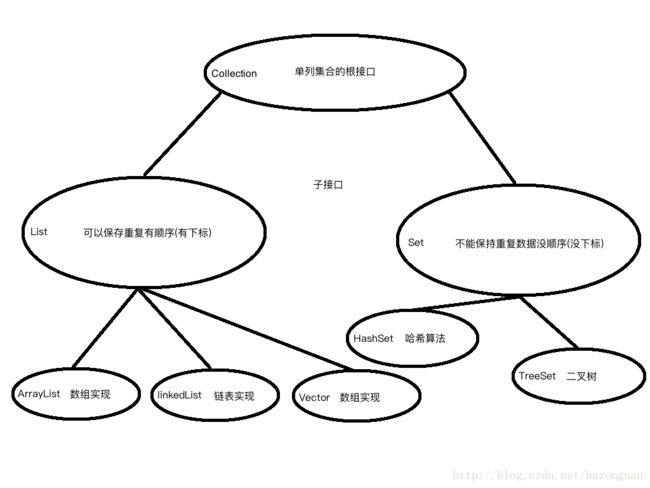Java 集合
集合
集合由来:数组操作数据的弊端
数组弊端:
1.只能添加相同类型的元素(基本数据类型和引用数据类型)
2.长度一旦确定,就不能改变
要添加超出数组长度个数的元素,操作复杂
集合的特点:
1.能添加不同类型的元素
注意:集合中只能添加引用数据类型(对象类型)
2.长度可变
集合框架体系
集合的基本方法
// 创建集合 多态的声明方式
Collection collection = new ArrayList();
// 添加方法
// 向集合中添加基本数据类型的时候
// 系统会自动装箱,把基本数据类型变成该数据类型的包装类
// ArrayList 中的 add 方法不可能返回失败
// 因为没有写返回 false 的判断 只有 true
// 思考:不能返回失败,为什么还要设计返回值呢?(思想)
// 要适用所有的子类,子接口
boolean add = collection.add("a");
boolean add2 = collection.add("b");
boolean add3 = collection.add("c");
boolean add4 = collection.add(10);
boolean add5 = collection.add(true);
// 打印集合
System.out.println(collection.toString());
// 获取集合长度
int size = collection.size();
System.out.println(size);
// 判断包含
boolean contains = collection.contains(10);
System.out.println(contains);
// 删除
boolean remove = collection.remove(true);
System.out.println(remove);
// 操作的是集合本身
System.out.println(collection);
// 判断集合是否为空
boolean empty = collection.isEmpty();
System.out.println(empty);
// 清空数组
collection.clear();
System.out.println(collection);打印字符串
private static void function() {
Collection collection = new ArrayList();
collection.add("a");
collection.add("b");
collection.add("c");
collection.add("d");
// 遍历集合中的每个元素(集合转数组)
Object[] array = collection.toArray();
for (int i = 0; i < array.length; i++) {
System.out.println(array[i]);
}
}创建一个集合,加入三个学生,从集合中取出学生姓名
private static void function() {
Collection collection = new ArrayList();
collection.add(new Student("学生1", 18));
collection.add(new Student("学生2", 18));
collection.add(new Student("学生3", 18));
// 集合转数组(相当于有一个向上转型的操作)
// 对象调方法(强转注意:把数组中每一个对象进行强转,
而不是把保存对象的容器(数组)转化)
Object[] array = collection.toArray();
// 遍历数组
for (int i = 0; i < array.length; i++) {
// array[i] 直接从数组中取出来是 Object 类型
// 要想使用 Student 类中的方法,需要强壮
// 注意:必须是这个类型,才能强转成这个类型!
Student student = (Student)array[i];
System.out.println(student.getName());
}
}
错误的强转方式
public static void function() {
Collection collection = new ArrayList();
collection.add(new Student("学生1", 18));
collection.add(new Student("学生2", 18));
collection.add(new Student("学生3", 18));
Student[] array = (Student[])collection.toArray();
for (Student student : array) {
System.out.println(student);
}
}addAll
private static void function() {
Collection collection = new ArrayList();
collection.add("a");
collection.add("b");
collection.add("c");
Collection collection2 = new ArrayList();
collection2.add("x");
collection2.add("y");
collection2.add("z");
// 给集合 collection 添加一个元素,这个元素是 collection2
// collection.add(collection2);
// System.out.println(collection);
// 调用要测试的方法
collection.addAll(collection2);
// 查看调用后效果
// 把 collection2集合中每一个元素取出来添加到 collection 集合中
System.out.println("c:" + collection);
System.out.println("c2:" + collection2);
}removeAll
private static void function() {
Collection collection = new ArrayList();
collection.add("a");
collection.add("b");
collection.add("c");
Collection collection2 = new ArrayList();
collection2.add("x");
collection2.add("y");
collection2.add("z");
// 集合调用方法,将该集合中两个集合相同的所有元素删除
collection.removeAll(collection2);
System.out.println("c:" + collection);
System.out.println("c2:" + collection2);
}retainAll
private static void function() {
Collection collection = new ArrayList();
collection.add("a");
collection.add("b");
collection.add("c");
Collection collection2 = new ArrayList();
collection2.add("x");
collection2.add("y");
collection2.add("z");
// 集合调用方法,把两个集合的交集取出来,保存到该集合,其他元素删除
// 如果 collection 集合和 collection2 求出交集放到 collection 中
// 如果 collection 和原来对比,发生变化返回 true
// 不发生变化返回 false
collection.retainAll(collection2);
System.out.println("c:" + collection);
System.out.println("c2:" + collection2);
}迭代器(遍历)
// 测试迭代器中的方法
Collection collection = new ArrayList();
collection.add("a");
collection.add("b");
collection.add("c");
// 获取集合中的迭代器
Iterator iterator = collection.iterator();
// 先判断集合中是否有元素
boolean hasNext = iterator.hasNext();
System.out.println(hasNext);
// 从集合中取出元素
Object next = iterator.next();
System.out.println(next);遍历集合
private static void function() {
Collection collection = new ArrayList();
// 迭代时,有一个指针,指向集合首位置
// 每调用一次 next 方法,指针就向下移一格
collection.add("a");
collection.add("b");
collection.add("c");
// 遍历集合
Iterator iterator = collection.iterator();
// 如果有元素就获取没元素就停止循环
while (iterator.hasNext()) {
// 注意:迭代时循环中只能使用一次 next() 方法
System.out.println(iterator.next());
}
}创建一个集合
保存3学生
使用迭代器遍历,打印学生姓名
private static void function() {
Collection collection = new ArrayList();
collection.add(new Student("学生1", 18));
collection.add(new Student("学生2", 18));
collection.add(new Student("学生3", 18));
// 获取集合中迭代器
Iterator iterator = collection.iterator();
// 循环获取对象
while (iterator.hasNext()) {
// 获取元素
Object next = iterator.next();
// 强转成 Student 类型
Student student = (Student) next;
// 打印姓名
System.out.println(student.getName());
}
}综合引用–图书馆
/*
* 书类
* 书名
* 作者
*/
public class Books {
private String bookName;// 书名
private String author;// 作者
public Books() {
super();
// TODO Auto-generated constructor stub
}
public Books(String bookName, String author) {
super();
this.bookName = bookName;
this.author = author;
}
public String getBookName() {
return bookName;
}
public void setBookName(String bookName) {
this.bookName = bookName;
}
public String getAuthor() {
return author;
}
public void setAuthor(String author) {
this.author = author;
}
@Override
public String toString() {
return "[书名:" + bookName + ", 作者:" + author + "]";
}
}
/*
* 需求:
* 创建图书馆类 有名字 保存图书 打印所有图书的信息
*/
import java.util.ArrayList;
import java.util.Arrays;
import java.util.Collection;
import java.util.Iterator;
@SuppressWarnings({"rawtypes", "unused","unchecked"})
public class Library {
private String libraryName;// 图书馆名字
// 保存图书的容器
// 集合必须进行初始化(创建集合对象),才能添加元素,可以在构造方法中初始化
private Collection books;
public Library() {
super();
// 调用无参时,也能创建出保存书的容器
this.books = new ArrayList();
}
// 有参的构造方法,只提供一个图书馆名字的参数就可以
public Library(String libraryName) {
super();
this.libraryName = libraryName;
// 创建保存书的容器
this.books = new ArrayList();
}
public String getLibraryName() {
return libraryName;
}
public void setLibraryName(String libraryName) {
this.libraryName = libraryName;
}
public Collection getBooks() {
return books;
}
public void setBooks(Collection books) {
this.books = books;
}
@Override
public String toString() {
return "[图书馆名=" + libraryName + ", 书名=" + books + "]";
}
// 添加书的方法
public void addBook(Books books) {
// 把书添加到容器中
this.books.add(books);
}
// 打印所有书的方法
public void print() {
System.out.println(getLibraryName());
// 遍历集合
Iterator iterator = this.books.iterator();
while (iterator.hasNext()) {
// 获取集合中的元素
Object next = iterator.next();
// 强制转换成书
Books books = (Books) next;
// 打印书
System.out.println(books);
}
}
}
public class Test {
public static void main(String[] args) {
Library library = new Library("图书馆");
// 添加书
library.addBook(new Books("西游记", "吴承恩"));
library.addBook(new Books("水浒传", "施耐庵"));
library.addBook(new Books("红楼梦", "曹雪芹"));
library.addBook(new Books("三国演义", "罗贯中"));
// 打印图书馆信息
}
}http://blog.csdn.net/huzongnan/article/list
